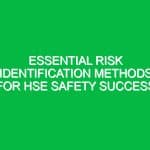Introduction
In today’s rapidly evolving industrial landscape, the significance of a robust risk management assessment cannot be overstated, especially in the context of Health, Safety, and Environment (HSE). Risk management assessment refers to the systematic process of identifying, evaluating, and mitigating risks that could potentially harm individuals, property, or the environment. This approach is crucial in HSE as it lays the groundwork for creating safe and sustainable workplaces. By understanding and managing risks effectively, organizations can not only comply with legal requirements but also foster a culture of Safety that enhances productivity and employee morale.
This article explores essential aspects of risk management assessment within the HSE domain, providing insights into methodologies, best practices, and regulatory frameworks that govern this critical process. Through real-life examples and actionable advice, we aim to equip you with the knowledge needed to unlock Safety success in your organization.
The Core Components of Risk Management Assessment in HSE
The risk management assessment process involves several key components that are integral to ensuring effective health, safety, and environmental practices. Understanding these components helps organizations develop a comprehensive risk management strategy. Here are the primary elements:
1. Risk Identification
Risk identification is the first step in the risk management process. It involves recognizing potential Hazards that could cause harm. Hazards can be physical, chemical, biological, or ergonomic. For instance, in a manufacturing setting, the risk of machinery accidents, exposure to toxic substances, or slips and falls must be identified. Techniques such as workplace inspections, employee feedback, and reviewing incident reports can be employed to uncover potential risks.
2. Risk Assessment
Once risks are identified, the next step is to assess their potential impact and likelihood. This involves analyzing the severity of each risk and determining how probable it is to occur. Organizations often use qualitative and quantitative methods for this assessment. For example, a qualitative approach may involve categorizing risks as low, medium, or high, while a quantitative approach may involve statistical analysis to predict incident rates. A real-life example can be drawn from a chemical plant where a thorough risk assessment revealed that a specific chemical spill posed a high risk due to its toxicity and potential for widespread harm.
3. Risk Control Measures
After assessing the risks, organizations must implement Control Measures to mitigate them. This can include engineering controls, administrative controls, and Personal Protective Equipment (PPE). For instance, installing safety guards on machinery, developing standard operating Procedures (SOPs), and ensuring employees wear appropriate PPE are all strategies to minimize risks. A notable case is that of a construction site where the implementation of strict safety protocols significantly reduced accidents and injuries, demonstrating the effectiveness of appropriate risk control measures.
4. Monitoring and Review
Risk management is an ongoing process. Continuous monitoring and review of risk management strategies are essential to adapt to changing circumstances. Regular audits, safety drills, and feedback mechanisms help organizations assess the effectiveness of their risk control measures and make necessary adjustments. For example, after a series of near-miss incidents, a company may decide to enhance Training programs or modify work procedures to address the identified gaps.
5. Documentation and Reporting
Proper documentation is critical in risk management assessment. It ensures that all processes, evaluations, and actions taken are recorded for future reference. This documentation not only helps in compliance with Regulations but also serves as a valuable resource for training and continuous improvement. Reporting mechanisms should be in place to communicate risks and control measures to all stakeholders, creating a transparent safety culture.
Best Practices in Risk Management Assessment
Implementing Best Practices in risk management assessment enhances the effectiveness of HSE efforts. Here are several key practices to consider:
1. Engage Employees
Involving employees in the risk management process fosters a sense of ownership and accountability. Employees are often the first to notice potential Hazards, and their insights can be invaluable. Regular safety meetings and open communication channels can help ensure that everyone is engaged in maintaining a safe work environment.
2. Conduct Regular Training
Training plays a vital role in risk management assessment. Providing employees with ongoing education about safety practices, hazard recognition, and emergency procedures equips them with the knowledge necessary to identify and mitigate risks effectively. For instance, a public utilities company that conducts regular training sessions has seen a significant reduction in workplace accidents.
3. Embrace Technology
Leveraging technology can streamline risk management processes. Tools such as risk assessment software, incident reporting applications, and data analytics platforms can facilitate real-time monitoring and reporting. For example, a construction firm using a digital platform for safety audits observed improved compliance and faster identification of potential hazards.
4. Foster a Safety Culture
Creating a safety-first culture within the organization is crucial. Leadership commitment to HSE practices sets the tone for the entire organization. Recognizing and rewarding safe behavior encourages employees to prioritize safety in their daily activities. One manufacturing company implemented a safety incentive program, leading to increased participation in safety initiatives and a notable decline in incidents.
Regulations and Standards Governing Risk Management Assessment
Understanding the regulatory landscape is essential for effective risk management assessment in HSE. Numerous regulations and standards guide organizations in establishing and maintaining safety practices. Here are some key regulations to consider:
1. Occupational Safety and Health Administration (OSHA)
osha sets and enforces standards to ensure Workplace Safety and health. Compliance with OSHA regulations is mandatory for most employers in the United States. Organizations must conduct risk assessments to identify hazards and implement appropriate control measures as outlined in OSHA standards.
2. Environmental Protection Agency (EPA)
The EPA regulates environmental hazards and ensures compliance with environmental laws. Organizations must assess potential environmental risks associated with their operations and implement measures to mitigate these risks. Failure to comply with EPA regulations can result in severe penalties and damage to an organization’s reputation.
3. ISO 45001 Standards
ISO 45001 is an international standard for Occupational Health and safety management systems. It provides a framework for organizations to proactively improve their safety performance. Adopting ISO 45001 standards involves conducting regular risk assessments and implementing a systematic approach to hazard management.
Conclusion
In conclusion, effective risk management assessment is a cornerstone of health, safety, and environmental success in any organization. By systematically identifying, assessing, and controlling risks, organizations not only protect their employees and assets but also enhance their overall operational efficiency. The importance of fostering a safety culture, engaging employees, and adhering to regulatory standards cannot be overstated. As industries continue to evolve, the commitment to robust risk management practices will be key in navigating the complexities of modern Workplace Safety and environmental Sustainability.
Ultimately, organizations must view risk management assessment not as a compliance obligation but as an opportunity to unlock safety success. By embracing this proactive approach, they can not only safeguard their workforce and the environment but also drive sustainable growth and innovation. It is time to prioritize risk management assessment and make it an integral part of your organizational strategy for a safer, more sustainable future.


